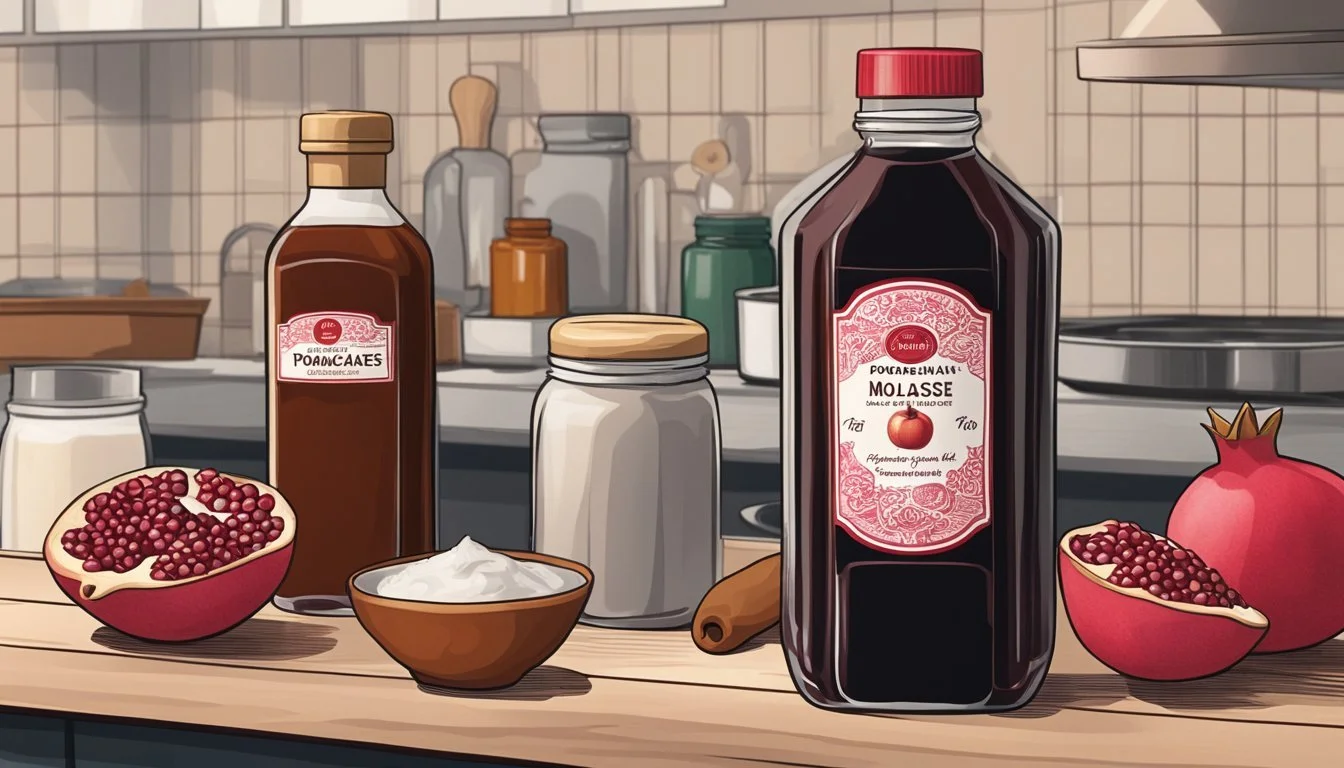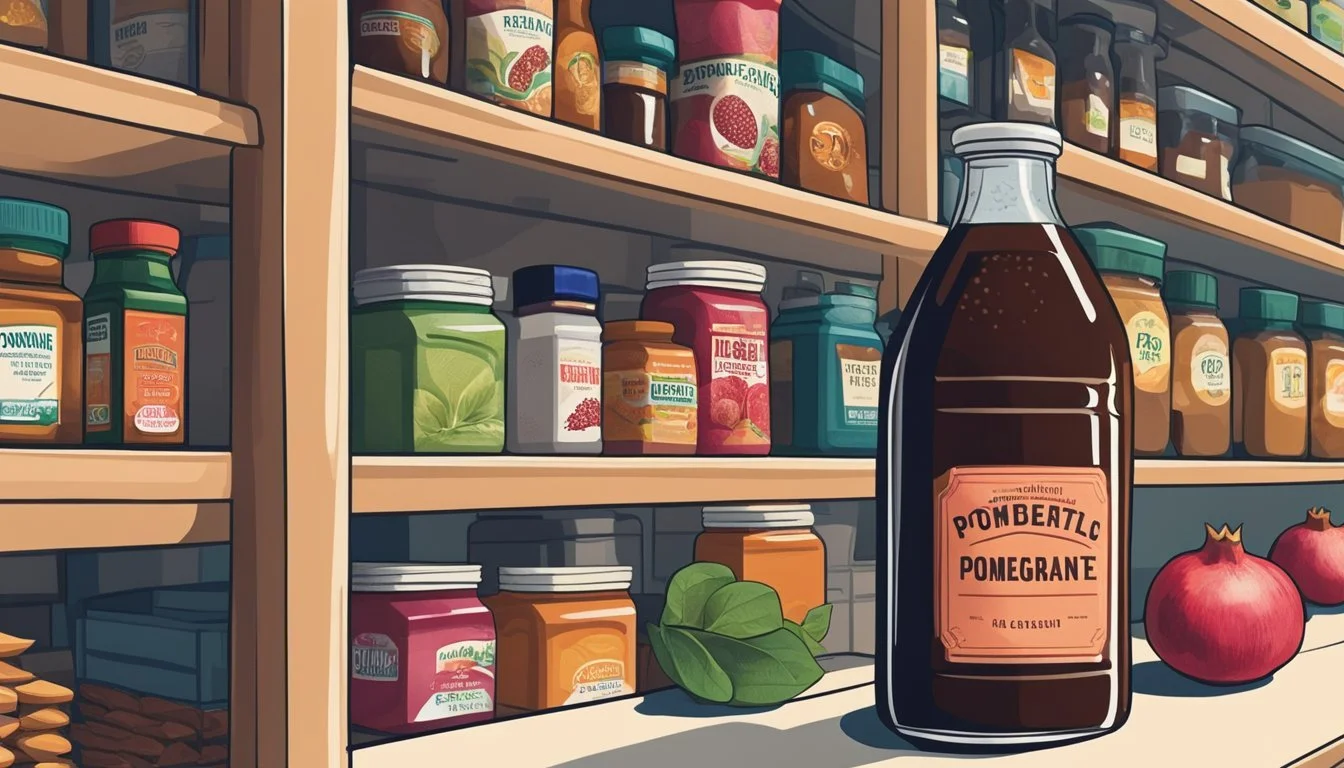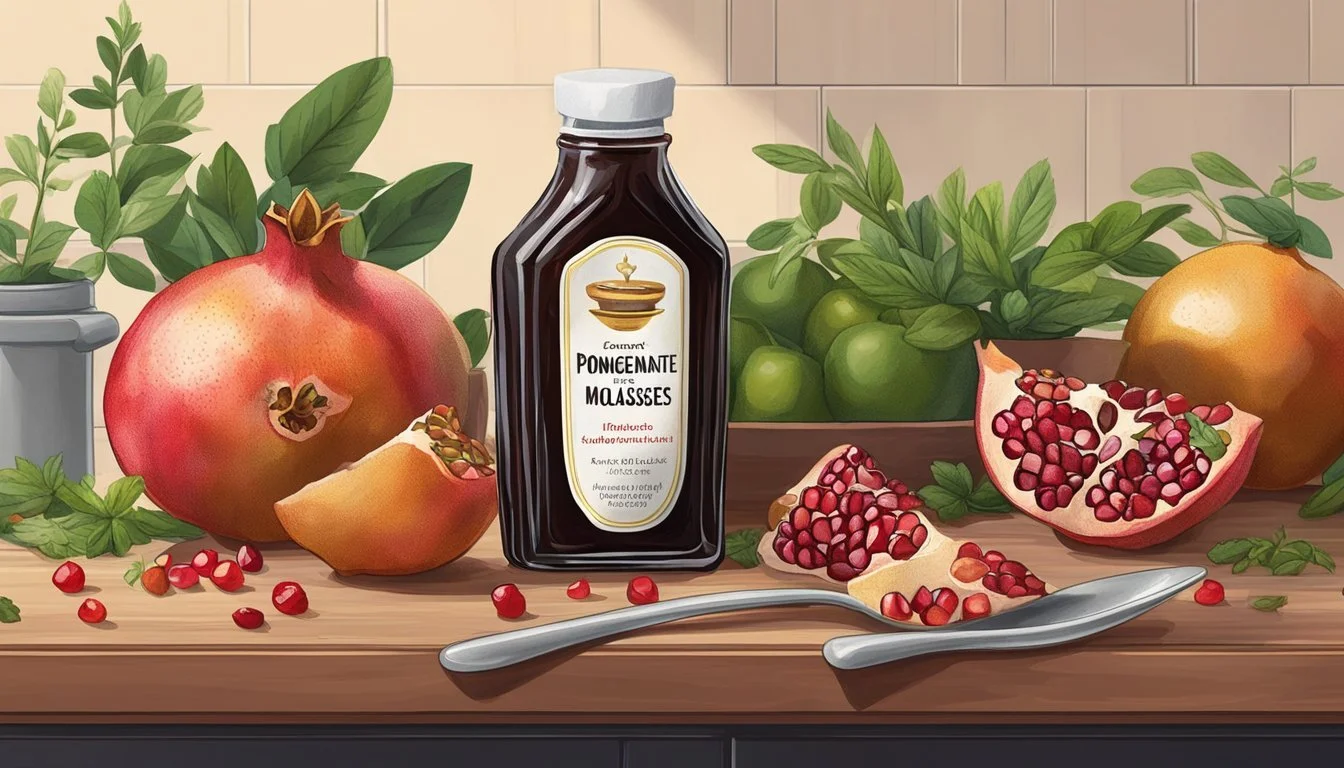How Long Does Pomegranate Molasses Last?
Unveiling Shelf Life and Storage Tips
Pomegranate molasses is a syrup-like reduction made from pomegranate juice, sugar, and often lemon juice or vinegar. Esteemed for its tangy flavor and its versatility in the culinary world, it serves as a condiment and flavor enhancer in a variety of Middle Eastern dishes. Its unique taste, neither purely sweet nor sour, allows it to add depth to sauces, marinades, and dressings.
The shelf life of pomegranate molasses is typically around 12 months when kept in optimal conditions. To preserve its quality, it should be stored in a cool, dark place such as a pantry or cupboard. Once opened, it is generally accepted that pomegranate molasses remains usable for a prolonged period if properly sealed and stored in the refrigerator.
With its increasing popularity in global cuisine, understanding the storage and longevity of pomegranate molasses is valuable for both chefs and culinary enthusiasts who wish to harness its distinctive flavor without compromise. Although pomegranate molasses is sometimes confused with molasses made from sugar cane, it is a completely different product, specifically derived from the reduction of pomegranate juice.
Understanding Pomegranate Molasses
Pomegranate Molasses is a versatile condiment known for its unique sweet and tangy flavor, and is a staple ingredient in Middle Eastern cuisine.
Ingredients and Flavor Profile
Pomegranate molasses is crafted from pomegranate juice that is simmered down to a thick syrup. Often, lemon juice and sugar are added to adjust the tartness and sweetness, enhancing its complex flavor profile. The resulting molasses has a tangy, sour taste with a sweet undertone and an aromatic flavor that is highly concentrated. Its aroma is just as distinctive and adds depth to various dishes.
Pomegranate Molasses in Middle Eastern Cuisine
In Middle Eastern cuisine, pomegranate molasses is a fundamental ingredient used in a variety of recipes. It adds a rich, tangy punch to sauces, marinades, and dressings. It's also frequently incorporated into traditional dishes to lend a sour yet slightly sweet complexity. Notably, it serves as a key component in several recipes, complementing meats, vegetables, and is often drizzled over desserts for an extra layer of flavor.
Storage Guidelines
The proper storage of pomegranate molasses is crucial to maintain its quality and extend its shelf life. By adhering to specific guidelines for refrigeration and pantry storage, understanding shelf life indicators, and recognizing spoilage signs, consumers can ensure the condiment remains in its best condition.
Refrigeration and Pantry Storage
Pomegranate molasses should be stored in a cool, dark place to preserve its quality, such as a pantry or cupboard. Once opened, keeping the molasses in the refrigerator is advisable to slow down any spoilage process. It's essential to keep the bottle tightly sealed to prevent exposure to moisture and other contaminants.
Shelf Life and Best By Date
Unopened pomegranate molasses typically has a shelf life of up to 12 months. To determine how long the product can be used after opening, consumers should refer to the best by date if available. While it might be safe to consume the molasses after this date, the quality may not be optimal.
Signs of Spoilage
Pomegranate molasses is prone to spoilage under improper storage conditions. Signs that the product has gone bad include the presence of mold, an unpleasant odor, or being discolored. Should any of these indications be present, it is important for safety reasons to discard the molasses.
Maximizing Shelf Life
To ensure pomegranate molasses retains its quality, one must focus on two critical aspects of storage: the integrity of the seal and the option of freezing. The viscosity and consistency of pomegranate molasses are best preserved when these storage methods are strictly followed.
Proper Sealing and Containers
To maximize shelf life, pomegranate molasses should be stored properly in a tightly sealed container to prevent exposure to air, which can degrade its quality. After each use, it is important to check that the lid is secure and that the container's seal is not compromised. It is advisable to transfer the molasses into a glass jar if its original packaging does not provide an airtight seal. Glass is non-reactive and does not absorb flavors or odors, which helps in maintaining the molasses' integrity.
Freezing Pomegranate Molasses
Freezing pomegranate molasses is an efficient way to extend its life beyond the typical one-year pantry shelf life. When freezing, ensure the pomegranate molasses is placed in a tightly sealed container or heavy-duty freezer bag to prevent freezer burn and to maintain its consistency and viscosity. To use, one must thaw the molasses in the refrigerator or at room temperature. Care should be taken to only thaw what is needed, and any remaining frozen portion should be returned to the freezer promptly.
Culinary Uses of Pomegranate Molasses
Pomegranate molasses, known for its sweet-tart flavor, acts as a versatile ingredient in recipes. It offers a distinctive tangy profile that enhances sauces, glazes, and dressings and can withstand varying levels of heat in cooking applications.
Dressings and Marinades
The complexity of pomegranate molasses—its balance of sweetness and tangy acidity—makes it a valuable asset in creating salad dressings and marinades. One can whisk it into vinaigrettes to introduce depth to a simple salad or mix it with olive oil to drizzle over a Mediterranean dish. Its rich flavor is assertive enough to stand up to robust greens and grains.
Marinades for meats benefit from pomegranate molasses as well. It not only imparts a unique flavor but also contributes to a caramelized glaze when the meat is cooked. Here’s how it can be utilized:
Combine with garlic, herbs, and oil to marinate red meats or poultry before grilling.
Whisk into a marinade base for fish, with the addition of citrus and spices.
Cooking with Pomegranate Molasses
In the realm of cooking, pomegranate molasses serves as a dynamic ingredient across an array of recipes. Its ability to contribute both a sweetness and a vivacious kick makes it suitable for working into a sauce for braised dishes (What wine goes well with braised dishes?), where it can simmer and intertwine with other flavors.
It’s also used in cooking techniques that involve heat applications, such as boiling or simmering, without losing its integral taste profile:
Use as a glaze on roasted vegetables (What wine goes well with roasted vegetables?) or meats by drizzling it towards the end of cooking to add a rich, caramelized layer.
Stir into stews and sauces to boil or simmer down to a thicker consistency, enhancing the existing dish with its concentrated essence.
In both raw and cooked form, pomegranate molasses adds a significant dimension to each recipe and dish it graces.
Health Benefits and Nutritional Information
Pomegranate molasses is a rich source of antioxidants and vitamins, contributing to its recognized health benefits. It also serves as a modest source of dietary fiber when consumed.
Antioxidants and Vitamins
Pomegranate molasses contains antioxidants such as polyphenols, which help protect the body's cells from damage due to free radicals. One key antioxidant present is Vitamin C—important for immune function and skin health. The molasses also offer a variety of B-vitamins, which support metabolism and contribute to the production of energy.
Nutrient Benefit Vitamin C Supports immune system, aids in skin health B-vitamins Assists metabolism and energy production
Dietary Fiber in Pomegranate Molasses
Although not a significant source of dietary fiber, pomegranate molasses provides a small amount. Dietary fiber contributes to digestive health and can aid in maintaining a healthy weight by promoting a feeling of fullness.
DIY Pomegranate Molasses
Creating homemade pomegranate molasses involves boiling down pomegranate juice, typically with added sugar and lemon juice, until it becomes a thick syrup. This condiment can range from tart to sweet and varies in viscosity and texture, depending on the preparation method.
Homemade Preparation
The key to preparing homemade pomegranate molasses is a simple process of simmering. One begins by combining pomegranate juice with a sweetening agent - commonly sugar. Lemon juice is also added, which plays a role as a natural preservative. This mixture is then boiled down over a gentle heat. To arrive at an ideal thickness and flavor, adjusting the sugar quantity is a common practice: more sugar for a sweeter, thicker molasses, or less for a thinner, more tart result. Moreover, homemade versions can be stored in airtight containers and typically have a generous shelf-life due to sugar and citrus acting as preservatives.
Consistency and Texture
As for the consistency and texture of homemade pomegranate molasses, it revolves around how long the mixture is simmered. The goal is to achieve a very thick, slick syrup, akin to the texture of honey or commercial molasses. While simmering, the mixture should be watched closely as it starts to reduce and crystallize, especially towards the end. One seeks a balance where the molasses has sufficient viscosity to pour smoothly but is not overly runny. It’s crucial not to over-reduce the juice, which may lead to a molasses that's too firm and difficult to use.
Pairing and Flavor Combinations
Pomegranate molasses offers a unique tangy yet sweet flavor that melds exceptionally well with a variety of foods and beverages. Its rich profile can accentuate the taste of both savory and sweet dishes while adding a touch of complexity to drinks.
Complementing Foods with Pomegranate Molasses
Salads: Pomegranate molasses can be the star ingredient in salad dressings, imparting a fruity, slightly sour punch that contrasts well with leafy greens. A drizzle on a salad with feta cheese adds a sweet and tangy flavor, especially when paired with roasted vegetables or fresh fruits.
Deserts: Its bold flavor also complements desserts such as ice cream or cheesecake, providing a rich fruitiness that balances the sweetness.
Sauces and Meats: It can be incorporated into sauces for an amplified taste when served with pork, beef, or salmon. When used as a drizzle, it not only garnishes but enhances the overall flavor profile of the dish.
A simple list for pairing with pomegranate molasses might include:
Vegetables: Roasted cauliflower, carrots, or brussels sprouts
Fruits: Sliced oranges, apples, or pears
Proteins: Grilled lamb, roast chicken, or pan-seared duck
Cocktails and Beverages
In the realm of beverages, pomegranate molasses can infuse a refreshing complexity into various drinks.
Cocktails: Skilled bartenders may incorporate pomegranate molasses into cocktails, crafting a rich, sour, and fruity base that is both invigorating and memorable.
Non-Alcoholic Options: Alternatively, a splash in sparkling water yields a quick and easy mocktail, or it can serve as a syrup base in crafted sodas for a more nuanced drink experience.
For a simple cocktail enhancement:
Mix 1 oz of pomegranate molasses with 2 oz of vodka and 4 oz of sparkling water.
Garnish with a sprig of mint or a twist of lemon zest (how long does lemon zest last?) for an aromatic finish.
Comparing Pomegranate Molasses to Other Sweeteners
Pomegranate molasses is distinctive among sweeteners, with unique storage and flavor properties that set it apart from traditional options like honey and maple syrup, as well as from other types of molasses.
Against Honey and Maple Syrup
Shelf Life: Honey is renowned for its nearly indefinite shelf life, largely due to its natural preservatives.
Storage: Proper storage is key; it should be kept in a tightly sealed container and away from moisture to maintain its quality.
Flavor Attributes: Honey possesses a signature floral aroma and flavor which varies based on the nectar source.
Shelf Life: An opened container of maple syrup typically lasts about 1 year if refrigerated correctly.
Storage: Like honey, maple syrup needs to be stored in a cool, dark place, preferably refrigerated after opening.
Flavor Attributes: Maple syrup offers a distinctively sweet, rich flavor with notes of caramel and woodiness.
Differences from Blackstrap Molasses
Blackstrap Molasses:
Derived From: It is a byproduct of sugar cane's refining process into sugar.
Shelf Life: While not as long-lasting as honey, it still offers a considerable shelf life when stored properly.
Taste and Aroma: Blackstrap molasses has a bolder, more robust flavor with a hint of bitterness and a note of sulfur, unlike the mildly tangy sweetness of pomegranate molasses.
Pomegranate Molasses:
Appearance: It is a thick, concentrated dark syrup with a glossy finish.
Sweetness vs. Sourness: It offers a balanced taste profile with both sweetness and a tart edge.
Usage: Commonly used in Middle Eastern cuisine, it adds depth of flavor that distinguishes it from the sweetness of blackstrap molasses.










